Multimedia as an ESP teaching aid at technical universities
DOI:
https://doi.org/10.15587/2519-4984.2017.100042Keywords:
multimedia, English for Specific Purposes, audiovisual aids, technical university, teaching, studentsAbstract
The article deals with the use of multimedia in English for Specific Purposes teaching at technical universities. The constituents of multimedia are presented at the beginning, along with the explanation of why the aforementioned means is considered as one of the best educational techniques. The advantages of the use of authentic multimedia in the ESP lesson are listed further in the paper. The reasons of possible negative outcomes of multimedia use in the foreign language lessons are briefly mentioned as well. The work contains the description of the process of educational material learning with the help of multimedia, and the explanation of the cognitive theory of multimedia learning (CTML), more specifically, its principles. When teaching students of technical specialties, it is vital to know that transfer learning is possible and even necessary; thus, this type of study can also be found in the proposed paper. The elements that influence the transfer learning success–mental model construction, working memory capacity, and comprehension–are provided. The experimental verification of the importance of multimedia in ESP lessons can be found at the end of the article
References
- Aloraini, S. (2012). The impact of using multimedia on students’ academic achievement in the College of Education at King Saud University. Journal of King Saud University – Languages and Translation, 24 (2), 75–82. doi: 10.1016/j.jksult.2012.05.002
- Austin, K. A. (2009). Multimedia learning: Cognitive individual differences and display design techniques predict transfer learning with multimedia learning modules. Computers & Education, 53 (4), 1339–1354. doi: 10.1016/j.compedu.2009.06.017
- Crosby, M. E., Stelovsky, J. (1995). From Multimedia Instruction to Multimedia Evaluation. Journal of Educational Multimedia and Hypermedia, 4 (2-3), 147–162.
- Mayer, R. E. (2001). Multimedia Learning. New York: Cambridge University Press, 210. doi: 10.1017/cbo9781139164603
- Yamauchi, L. G. (2008). Effects of multimedia instructional material on students’ learning and their perceptions of the instruction. Iowa: Iowa State University, 54.
- Fouda, O. (2008). Computer Uses in Education. Oxford: Elsevier Science Ltd.
- Mautone, P. D., Mayer, R. E. (2001). Signaling as a cognitive guide in multimedia learning. Journal of Educational Psychology, 93 (2), 377–389. doi: 10.1037/0022-0663.93.2.377
- Beichner, R. J. (1994). Multimedia Editing to Promote Science Learning. Journal of Computers in Mathematics and Science Teaching, 3, 55–70.
- Mayer, R. E., Griffith, E., Jurkowitz, I. T. N., Rothman, D. (2008). Increased interestingness of extraneous details in a multimedia science presentation leads to decreased learning. Journal of Experimental Psychology: Applied, 14 (4), 329–339. doi: 10.1037/a0013835
- Mayer, R. E. (2011). Applying the Science of Learning. Boston: Pearson, 144.
- Cree, V. E., Macaulay, C. (Eds.) (2000). Transfer of Learning in Professional and Vocational Education. London: Routledge, 224. doi: 10.4324/9780203134511
- Azevedo, R., Guthrie, J. T., Seibert, D. (2004). The Role of Self-Regulated Learning in Fostering Students’ Conceptual Understanding of Complex Systems with Hypermedia. Journal of Educational Computing Research, 30 (1-2), 87–111. doi: 10.2190/dvwx-gm1t-6thq-5wc7
- Meinz, E. J., Hambrick, D. Z. (2010). Deliberate Practice Is Necessary but Not Sufficient to Explain Individual Differences in Piano Sight-Reading Skill. Psychological Science, 21 (7), 914–919. doi: 10.1177/0956797610373933
- Oxford Dictionary of English (2003). Oxford: Oxford University Press, 2088.
- Bloom, B. (1956). Taxonomy of Educational Objectives: The Classification of Educational Goals. Harlow: Longman Group, 207.
Downloads
Published
How to Cite
Issue
Section
License
Copyright (c) 2017 Mariana Shevchenko

This work is licensed under a Creative Commons Attribution 4.0 International License.
Our journal abides by the Creative Commons CC BY copyright rights and permissions for open access journals.
Authors, who are published in this journal, agree to the following conditions:
1. The authors reserve the right to authorship of the work and pass the first publication right of this work to the journal under the terms of a Creative Commons CC BY, which allows others to freely distribute the published research with the obligatory reference to the authors of the original work and the first publication of the work in this journal.
2. The authors have the right to conclude separate supplement agreements that relate to non-exclusive work distribution in the form in which it has been published by the journal (for example, to upload the work to the online storage of the journal or publish it as part of a monograph), provided that the reference to the first publication of the work in this journal is included.








